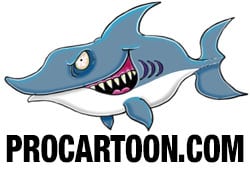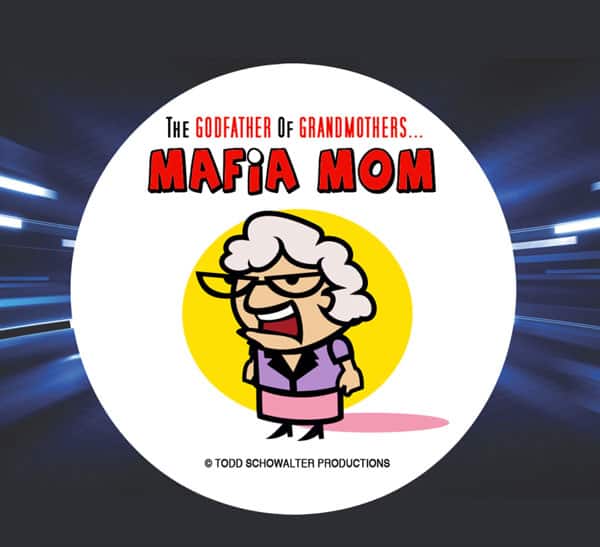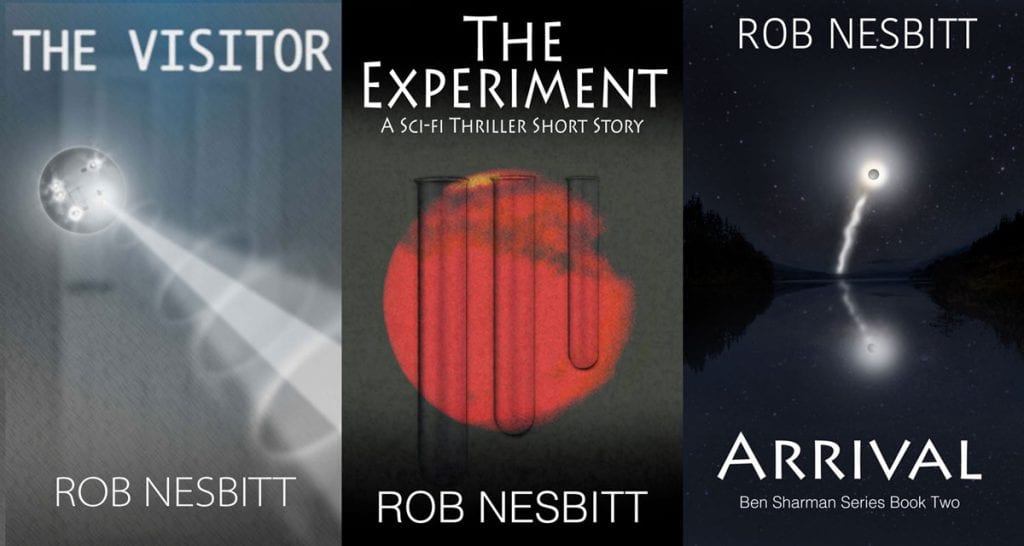Procartoon – Podcast 7 – Interview with Todd Schowalter
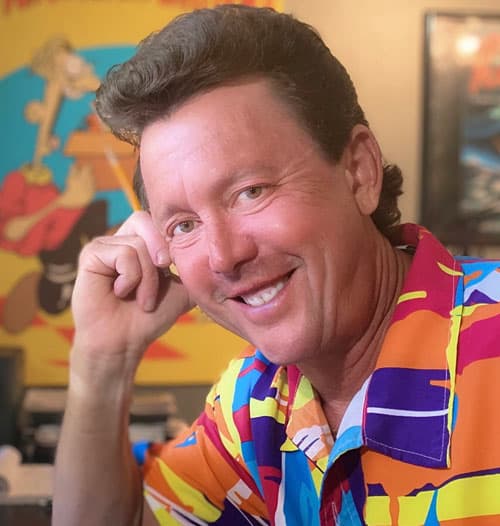 In this episode of the procartoon podcast, I interview Todd Schowalter from St. Louis in Missouri, a professional cartoonist, animator, and film producer who has many more talents besides.
In this episode of the procartoon podcast, I interview Todd Schowalter from St. Louis in Missouri, a professional cartoonist, animator, and film producer who has many more talents besides.
Todd talks about a brand new development, he is currently working on called ToonScreen, which allows cartoonists and cartoon animators to display their work globally and receive payment. It’s a great idea that cuts out the middleman and gatekeepers that stand in the way of getting your cartoon artwork published.
Since 1989 Todd Schowalter has had his cartoon work distributed nationally. His work has appeared internationally, featuring on television, advertisements, books, magazines and greetings cards.
When Hanna-Barbara optioned one of Todds cartoon strips, ‘Danny’s Dream Machine’ he expanded his cartoon business into the world of animation.
He now has an impressive catalogue of animated shorts which include: Ghost Dog, The Comic Strip, Manner Moose, Mafia Mom, (my particular favourite, with a brilliant tagline as it reminds me of my mother in law!) Dave and Jen, Mystic Planet, Leo and the Legend and InterPets.
I also give a personal update and answer more of your questions. I really appreciate your questions so keep them coming…it keeps me on my toes!
Scroll down to read the extensive show notes below in conjunction with the Podcast Audio – All links in the Podcast are detailed in the show notes plus additional images and screenshots to clarify and technical discussion in the text.
Procartoon Podcast 7 with Rob Nesbitt
This Episode is Sponsored by JohnOverall.com
WordPress and Web specialists.
Resources mentioned in the podcast:
Todd Schowalter web site: studiotodd.com
Where to sell your artwork on line: Article on procartoon.com
Procartoon Contacts page: For advertisers and anyone wishing to appear on the show
Show Notes for Procartoon Podcast 7
Hi everyone. I am going to start with a personal update…
We’re still in a partial pandemic lockdown over here in the UK but it has been a great time in one respect, to be creative.
I have done a lot of cartoon work over the lockdown, anticipating future events such as Christmas which is just over five months away. I have also been writing a series of Sci fo Novels and just finished the second in a trilogy.
Although not related to cartooning, the process of publishing my own novels for the Amazon KDP market has an artistic side. I looked at the price of getting covers produced by professional cover designers and shuddered. Hundreds of bucks per cover and I need quite a few.
So, I did what every professional book publishing pundit says not to do, and have started designing the covers myself. Take a look in the podcast show notes where I have put some of my first draft cover designs and see what you think. It has been an interesting challenge using PhotoShop!
I am still putting together my brass band cartoon book, which will be either printed or, put on Amazon’s print on demand service, ready for the Christmas market. This has been a nostalgia trip looking at the cartoons I have drawn and articles written for Brass Band World Magazine over the last 18 years.
Putting the best of them into one book has been quite interesting as I look at what I have done in the past, spotting mistakes…It’s funny…however closely you look, particularly if you do detailed cartoons, you can miss stuff. A few pixels missing here…an overlapping line there, that sort of thing.
I used to get really annoyed with myself but have learned to live with these little niggles. I can also see how I have advanced, over the years particularly with graphics software.
Moving on Here’s a couple of your questions which I always enjoy receiving as it keeps my cogs turning. Please keep sending them in through the contact page
The first question is from Jeff Allen from Utah in the US.
I use watercolours in my cartoons but can never seem to get bright colours. I am not technically minded and don’t like using a graphics tablet. Are there watercolour paints that provide more vibrant colours?
Great question Jeff. Getting watercolours to pop off the page can be difficult. As the name suggests they are pigments that are diluted with water and mainly used by artists for the incredible effects they can get with them, such as clouds, skies and water. Sometimes, increasing the pigment to water ration destroys the effect.
If you are looking for a flatter brighter colour then it might be worth trying acrylics instead which can be layered to give a really vibrant colour. If you want to maintain the watercolour feel I suggest you paint in watercolour then add chalk pastel over the top with some water for the areas you want to pop off the page.
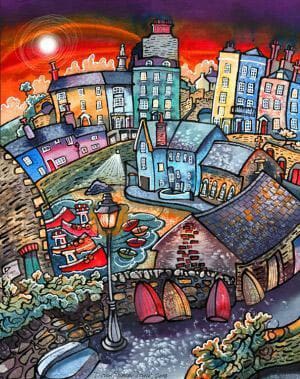
A picture paints a thousand words, and there is an example in the show notes of a painting by Welsh artist Dorian Spencer Davies who uses this process to create superb semi-cartoon style watercolours of Welsh towns and seaside resorts.
I asked him how he manages to get such vibrant colours, expecting him to say that he uses some mega-expensive paint but no! It’s just a box of chalk pastels mixed with water. Try it. I did and it works really well. You can either apply them dry then add a wet brush or apply wet chalk pastel pigment on the brush. Suggest you try both!
The next question is from Caroline Jones from just down the road from me in Cardiff, sunny South Wales in the UK.
I have a clerical day job and want to start selling my cartoon artwork as a sideline. What is the best way to get my work noticed when I have very little spare cash to advertise?
I think every one of us has been in that position. I don’t like spending bucket loads of cash but that’s the miser in me I suppose! We are in the best time ever for artists to get their artwork out there globally, and It doesn’t have to break the bank.
You can create a Facebook business page for free – I have several for the various businesses and projects I run. You can display your work, invite all your Facebook friends to like the page, and start getting yourself and your cartoons known.
For not a lot of money, you can advertise on Facebook. I used it on my ‘nezzyonbrass’ Facebook page to build a community of followers in the brass banding world (my hobby). I gained an extra 1000+ in just a couple of months and these are all potential customers. You can also create a shop on Facebook and it’s all free!
Cartoon work also suits Instagram which is fast becoming a huge platform for artists. I have only just ventured into this myself as my wife loves gardening and taking photos of flowers that she grows. She now has 1500 followers on Instagram or flowerers as she calls them and that has only taken around five months!
Twitter isn’t something I would recommend for advertising as I have not had decent results but others may disagree.
I would also look at getting your own web site with a shop or you could use a third party such as ETSY where you can create a shop and they take a small cut for advertising and sales. As I said – it has never been a better time to get your work out there.
I have written an extensive article on where to sell your artwork. You can find the link in the show notes.
Interview with Todd Schowalter
I now move on to the main feature of this podcast – an interview with Todd Schowalter. Todd is a multi-talented cartoonist, animator, actor, producer and stand up comedian who runs his own company Todd Schowalter Productions. His cartoon work has been distributed nationally and cartoons and animation work has been seen globally through television, books, adverts and a host of other media.
Todd, originally from Texas now lives in St Louis, Missouri with his family.
Rob: Hi, Todd and welcome to the Procartoon podcast. It’s great to have you on the show.
Todd: Thanks, Rob. It’s great to be here.
Rob: When did your cartoon career begin and what was the influence that made you start drawing cartoons?
Todd: I’ve been drawing my entire life. I used to draw on the furniture with my mom’s lipstick. I guess I’ve been drawing since I was born, so to speak, but I drew through school.
Until I was 14, I hadn’t made a dime from it. When I was 14, I actually got a job as the editorial cartoonist for an African-American paper in St. Louis, Missouri, which was really quite the experience. I used to go to work with my father down into the city every once in a while, it was back in the day when things were a little bit safer and he let me ride the bus.
One day, I actually took my mini-kid portfolio and just dropped in on this paper called the St. Louis Sentinel. They were gracious enough to meet with me and I guess they liked what they saw for a 14-year-old. If I look back at it now, I don’t know if they needed contacts or eyeglasses or what.
They took me on and I ended up working with them for a couple of years and it was quite the experience because again, they were an African-American paper, and I was Caucasian-White 14-year-old and it was eye-opening. That was my first paycheck as a cartoonist, so to speak, and just luckily went on from there.
Rob: That’s a very young start. I’ve never heard of that before, not that young anyway.
Todd: Well, at that point, you hadn’t become accustomed to a lot of rejection. That comes with the game too. I think that’s important, regardless if you’re a 14-year-old kid, or whether you’re a 44 or anything. You’ve got to put yourself out there because if you don’t get in the game, you’re not going to play, and it’s really important regardless of what age you’re at.
I was naive, I was a kid but they were nice enough and gracious enough to take a chance on me. It was a great experience and that was pretty much the beginning of my career, so to speak. I’ve been drawing my whole life.
Rob: That’s a great kick-starter for anybody isn’t it, in the cartoon industry? Are there any other artists in your family?
Todd: Well, my mom, she’s retired but she was an interior designer. My grandfather, he was a very good draftsman, he was going to go to architectural school but that was back in the ’30s and whatnot and he ended up having to support the family.
There aren’t any cartoonists, professional ones in the family but I guess the closest would be my mom. She’s always been very artistic but she did it in a different medium, interior design. It’s mainly a family of lawyers, believe it or not. That’s where I get my sense of humour.
Rob: Are you a full-time cartoonist?
Todd: Yes, I am. Also, I’m a cartoonist, animator, and film producer. I juggle them all and people wonder what the heck I’m doing on at any moment of the day.
Rob: Your resume is diverse as you’ve just said, you’re a cartoonist, actor, producer, stand-up comedian, and much more. That’s a lot to pack into one career. Taking a couple of these diverse skills, stand-up comedian, an actor/ producer, I wondered how you came across doing this and how you develop the skills to do it?
Todd: They may be diverse and a lot of different roles so to speak, but they’re all tied together. Acting and producing ties very nicely into cartooning. Cartooning, you’re basically setting your stage, you’re writing your script, you have your characters which you’re creating, and it’s really very similar to a play or a film or anything else because rather than using the medium of film, you’re using the medium of either the palette or your paper or even your screen.
A lot of them go hand in hand. It’s not like I’m doing an oil change one day and flying an airliner the next and doing heart surgery, the next. They’re all inter-combined. I don’t like being tied to one single thing because I tend to get bored. I like juggling and multitasking and working on a lot of projects because I think it really helps you creatively.
I think if you get stuck in a rut in one area, you can shift gears and start working on something else that you’ve got going. By doing that, taking that break, you put your creativity into something different but it also rejuvenates you when you go back to what you were working on earlier.
It’s really not that far fetched and it’s really not that hard to do. I enjoy it. It keeps me fresh.
Rob: The only thing I find is that sometimes you can get too creative and you get frustrated because you want to do six different things at once so you get side-tracked. I don’t know if that’s the same for you?
Todd: Well, yes but that’s okay. You don’t have to do it all at once. I take elements out of each day, and that may apply to something else. I’ll tell you a quick story about a film that we’re producing right now. I read a story in the paper a couple of weeks ago that just struck me as funny. The subject matter is not funny, but it’s about a homeless camp where the leader loses it and they have to protect themselves from this guy and find a new leader. This was a real story in the paper.
I said, “Well, this will make a film.” I started working on that script. Now, earlier in the morning, I had no intention of doing that but that’s why I’m saying you shift, and at the same time when I’m working on my cartoons, the ideas for gags and storylines and things like that they come throughout the day. They come throughout the week. It’s not like I give myself a certain minute or block in the clock, so to speak, to actually do my work, that stuff is coming all the time.
I think by keeping your mind open to a lot of different things, you experience more, and anything regardless of what it is can be applied to one of those mediums creatively. That’s what I enjoy about it.
Rob: I think as a cartoonist you can see things that a lot of people can’t and see the funny angle on it.
Todd: That’s just it. You’re just making observations, looking at them slightly differently, and taking something that everybody is aware of it, and knows about and bringing out the funny aspect of it. Definitely.
Rob: Your cartoons have a very high-quality commercial feel. How do you produce them? Is it on a graphics package or do you hand draw, or is it is a combination of both?
Todd: Well, what I do right now, I am going to experiment with a Cintiq down the line. What I’ve done forever including to this day, I still use a pencil, regular paper.
I start out with a sketch so it goes right from my hand onto the paper. I like the organic feel of that. Typically, what I do after that is me and I’ll take care of the lettering or do the inking whether it’s on Bristol board with a dip pen C5, Speedball or I use a lot of micron pens.
I’ll actually do it by hand because you get that natural feel, I don’t like the real kind of manufactured look. Also with that, I’ll take the hand drawings, hand-ink games, I’ll scan them, and typically from there, I’ll work in Photoshop for any colourwork or change them into the formats I need to actually be published or go online. It’s a combination, but the beginning still always comes from the pen and paper.
Rob: Yes, I thought when I first bought a graphics tablet, I could wave goodbye to all the pencils but, no. The same thing, I just love the feel of a pencil in my hand on the surface of paper. There’s something magical about it that I can’t let go.
Todd: It has an organic feel. I try to explain it to some people. Another thing, as a Centiq guy, I think the drawing tabs, I wasn’t trying to promote them in particular, I’m just saying that’s what I’m looking at.
I’ll be interested to see how it works but it’s like if you have albums or records, of 45 as opposed to CDs. CDs you’ve got that crisp, clear sound, but with records and albums and things like that, you get that gritty poppiness and things like that it gives it like I said an organic feel to it.
I just think you accomplished that more with a pen and paper or Bristol board, whatever you’re using than you can just digitally because I think it has its limitations where pen and paper, you can do anything and scan it and there you go.
Rob: As a cartoonist, who are your biggest influencers?
Todd: Growing up, I liked a lot of people. I mean, Charles Shulz which I have a funny story about him, I got to meet him later on down the road. He was always a big influence, whether it be the characters, the specials on television, or even the strip as I moved along Berkeley Breathed. I liked him a lot as I moved into my college years, and I was fortunate enough to get in touch with him as well. I followed him, I liked his humour. He came when Doonesbury was on hiatus, I think he took history up to another level. I always admired him a lot.
Obviously, Bill Watterson of the Calvin and Hobbes, it’s one of the classics. That’s the top in my opinion. Gary Larson, probably the best gag writer, a panel of cartoonists said. He’s still out there, and he’s coming back by the way. But they were a variety.
I can’t really say that there was one cartoonist I really wanted to be like because I like different cartoonists for different reasons. I liked a certain cartoonist’s writing style, where I liked other cartoonists’ artwork. I would admire them for different reasons rather than just as a cartoonist as a whole. Fortunately, I’ve gotten to meet a lot of them through the National Cartoonists Society, so that’s been a big thrill.
I was at the Reuben Awards one year. We were in San Francisco and like I said, I’d followed Charles Shulz my entire life. I don’t know if it’s the look of our name. My last name is S-C-H-O, his S-C-H-U. I don’t know why we were all in close proximity as we were, but he and I ended up sitting together on the transport bus taking us to a hospital to draw pictures for the kids in the hospital. It was really wild because you grow up idolizing somebody and there he is sitting right next to you, but he was gracious and he was a great guy. His wife Jean is very nice also. That was one of the highlights of my cartooning career, is just talking with him.
Rob: Going back to the one that you said, Larson. Gary Larson.
Todd: Gary Larson, yes.
Rob: I absolutely love his stuff. It just cracks me up. A lot of other stuff is just visual. I think that’s probably the most difficult to do – a visual rather than the gag going with it.
Todd: Oh, absolutely. He’s coming back by the way. He’ll be with, I don’t know if it’s come out, Uclick. Andrews McMeel, he’s with them still I believe.
I read a funny story about Gary. Apparently, his studio’s drawing board overlooks a beautiful alp in the Northwest of the United States. It’s got a beautiful view of whatever they have, the Northwest mountains or whatnot.
Apparently though, even with that beautiful view, he doesn’t see it because he draws his cartoons at night when it’s pitch black. That’s when he actually does his cartoons. It doesn’t matter, he could be looking at a blank wall. I found that rather ironic. He’s got this great view but that’s not what he looks at. He’s looking at the dark when he draws his comics.
Rob: What is your process when you get a client that commissions you? How do you tackle that?
Todd: It depends on what the client wants and what the job is. A lot of times it’ll either be to develop a strip or develop a custom cartoon for something that they’re doing. I’m working right now on developing a whole cast of characters that are going to represent a product line. I like them to be part of the process so I do it in stages. Typically, I’ll have an evaluation stage where they’ll bring to the table what they expect, what kind of style they’re thinking, what kind of colour. What they want this project to accomplish because it’s all about results in the end.
Then I’ll have a three-step process where I’ll say, “Okay, we’re going to come out with three different directions. Which one of those directions do you feel strongest about?” I’ll tell you why. 80% of the time they pick the direction that I hate, which is good because you got to stay objective about it but it’s just like clockwork. I’ll tell my wife, “They’re going to pick this one because I hate it.” They pick that one.
After we get past that stage I’ll do a whole another series, and I’ll say, “Okay, let’s do two or three stages off of this series to see if we’re getting closer.”
At that point, I pretty much have the project locked in so I can do final art to finish the project. But it’s really important I find, especially if you’re dealing with committees because everybody seems to want to put their opinion in there just to justify their job or existence in the world. Good, you can get all of that preliminary feedback and let everybody get their two cents in early before you put all the end work in. I try to kind of coax them along.
I usually have three stages, and each stage has about three series to it. By the end, they feel good about it because they had things to check off along the way. I like it too because I haven’t wasted a lot of time going off in the wrong direction.
I know what they want, I know what I can bring to the table. It’s a lot of babysitting involved, but it makes my job easier because I know what they’re going for and I know what I can do to make it happen. I hope that makes sense.
Rob: No, perfect sense, because there’s nothing worse than producing something and then they say, “I didn’t really mean I wanted that.” You sound as if you’re nailing it to the floor before the final draft.
Have you ever had the client from hell? Without naming names.
Todd: Have I had a client, or which one? I’ve been doing this for 30 years and I could tell you– This could be a whole nother podcast.
Going back to the committee situation, inevitably, if there’s a committee, if you’re dealing with a bigger corporation or something like that, or a studio, that’s what you’re going to have to deal with.
Typically you’ll have everybody on board or almost everybody, but there’ll be that one that’s just got to rock the boat, “I don’t think his nose is quite big enough,” and you don’t know why.
It’ll be something just relatively out in the left-field but you’ve got to do something to make the unhappy– Give the cartoon character a nose job just to make this person happy, but there’s always that one. I can’t really pinpoint a worst. I’ve had some that have spun their wheels a lot.
Typically, with committees, you’re always going to deal with that one, but that said, we’ve always in every situation been able to come to a resolution about it.
Typically, you make the nose bigger, but not quite as big as everybody wanted. They’re happy, everybody else is happy, so the better. You get that dealing with one-on-one situations too, but the committees are the hardest for me.
Rob: [laughs] That’s great. What is your favourite medium for creating cartoons? I’m talking pencil, paint, or anything else that you use during the process of creation.
Todd: I’ve gone in different directions over the years. I was a big dip guy. I used C5 Speedballs, and then I’d use the B Models to do the lettering. And so I like the line fluctuation that the dip pens gave me on a Bristol board. I was a staff editorial cartoonist for two newspapers. Everything I did with that was pen and ink versus a dip pen.
The microns came along in the different weights and things of those pens. Those are just a lot easier. Obviously, if you’re on the run and you’re somewhere you can’t get out your indy ink and your dip pens, you can’t get your board and all that stuff. If I’m in a rush I would use my grunge, but then I kind of evolved more to that on a full-time basis.
Ironically, I’m going back right now and going back to try new dip pens again, so I go back and forth. It’s the only computer digital work I do at this point, still when it gets brought into Photoshop just for colouring or for export into different formats, whether it’s a JPEG, a PDF, whatnot, that’s typically the way I work.
Rob: In the UK we have the Cartoonists’ Club of Great Britain, which is open to published cartoonists in the UK. I think you’ve already touched on this, but what would be the equivalent in the USA, and what qualifies you to become a member?
Todd: There’ll be a National Cartoonists Society, the NCS. They’re not just in US, they’re worldwide. Entry, you need to make the majority of your income from cartooning. That’s going to be your main profession.
You can be doing something else but if your main occupation is a cartoonist then you’re pretty much eligible, and they do review your work. It’s not like a fraternity hazing or anything like that. I don’t know anybody that’s been a full-time cartoonist, or a majority of the time cartoonists ever be rejected because of their work. Fortunately, we have a lot of good people, but that’s pretty much it. You pay your dues.
They’re broken up into different chapters regionally. I’m the vice-chairman of the North Central chapter in the United States. There are I’d say about 10 different regional chapters, but everybody gets together for the big annual Reuben Awards, which is like the Academy Awards of cartooning. It’s typically at the end of May and obviously was postponed this year with– I don’t even know if they’re going to reschedule it because of everything going on, but everybody comes together for that. There are different category awards. That’s a good time. The National Cartoonists Society would be the equivalent of what you’re doing in the UK.
Rob: The UK version is for published cartoonists, but it’s more for professionals in the US by the sound of it then.
I understand you’re currently busy developing products including a new app. Could you tell us about your new innovations in the pipeline?
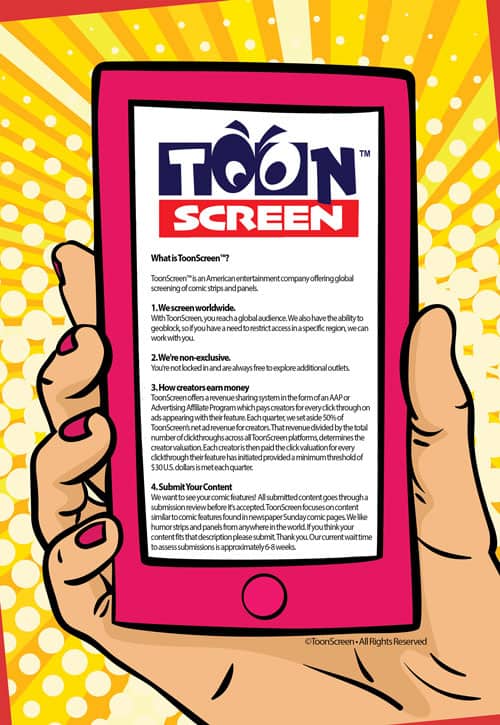 Todd: I mentioned before we started the podcast, I’ve got an app. that I’ve been developing called Toon Screen. What that is, is a new platform for cartoonists to hopefully monetize from, and also be a new medium to actually get out there and promote cartoonists’ work.
Todd: I mentioned before we started the podcast, I’ve got an app. that I’ve been developing called Toon Screen. What that is, is a new platform for cartoonists to hopefully monetize from, and also be a new medium to actually get out there and promote cartoonists’ work.
Right now, not just right now, it has been going on for several years, a lot of cartoonists are in flux and they don’t really know what they’re going to do because newspapers are going out of business, the comics pages are shrinking.
One of the reasons Bill Watterson left is just because they were shrinking the script so small. People are starting to freak out a little bit. They don’t know what’s going to happen.
There are different ways you’ve got to be able to pivot, and you’ve got to be able to transition into other mediums when that happens. Is the equivalent of when colour was added to black and white movies or sound was added. You’ve got to go along with that evolution.
A ToonScreen it would be an app. that would actually be a vehicle for comic strips and panels as well as animation, animated short series, things like that were based on how much exposure each feature gets.
That cartoonist would receive a part of whatever the profits were that the toon share actually received.
It’s very early in development. What I’m trying to do now is just get feedback from a lot of creators, cartoonists, and also the public. What they would like to see if something like this were to become available. That’s what that is. I’m looking for different outlets for cartooning that might not only help but expand where cartoon’s going.
The neat thing about that is a lot of cartoonists don’t think this way. Comic strips and even panels are created the way that they are based on column lengths in newspapers. You have your strip to fit the columns in a newspaper. Panels are the same way.
A visual screen like ToonScreen, you’re not confined to columns anymore. You have the whole screen that you can work with.
Back in the day with Terry and the Pirates and things like Steve Canyon, you had these brilliant Sunday cartoons that just don’t exist today. I think by bringing them to a visual medium like this, where you have a full screen as a palette to work with, that heyday may be yet to come. That’s the idea. That’s in development.
Rob: I think it’s a great idea. I have had a look at ToonScreen and I think that will really do well for you. I really do because here’s a lot of cartoonists. Exactly as you’ve said, they’re scraping around trying to find a way to get their work out there.
This is a great way of doing it worldwide. I’m making an affiliate for you out there work. I just think thumbs up to you. I think that’s a brilliant concept that you’ve come up with.
Todd: Thank you. I appreciate it. It is a labour of love, obviously, because I’m involved. I see these other cartoonists that are really animators. I’m just wondering, where the heck are we going?
This is an outlet. I think there are outlets that we haven’t even experienced that we were going to and rather than get discouraged, I think this is a big changing time. I think if people get in on the ground level now, it could just be like when the strips came out in the papers back at the beginning of the century over 100 years ago. This is the time to get excited rather than discouraged.
Rob: I was looking at it and it struck me as being similar to trying to get your book published with a traditional publisher which would be the newspaper. Along come you equivalent to a Kindle and you can self publish.
Todd: Great example.
Rob: Most people can really have a go with this and get their work out there. I think it’s great.
Todd: That’s a great way of putting it because that’s what it is. You have the device right in your hand. It’ll be available desktop too. If you’re anywhere you can have your comics right there, your animated show right there in your hands.
It’s easy, and the cartoonist is benefiting from it. A lot of people don’t like to hear this, but you’re cutting out the middleman because you’re going direct to the readers and the viewers, hose to the middleman which whether it be the syndicates or wire studios or whatnot. That’s the idea.
Rob: A difficult question for any cartoonist, but which piece of work would you rate as your absolute best?
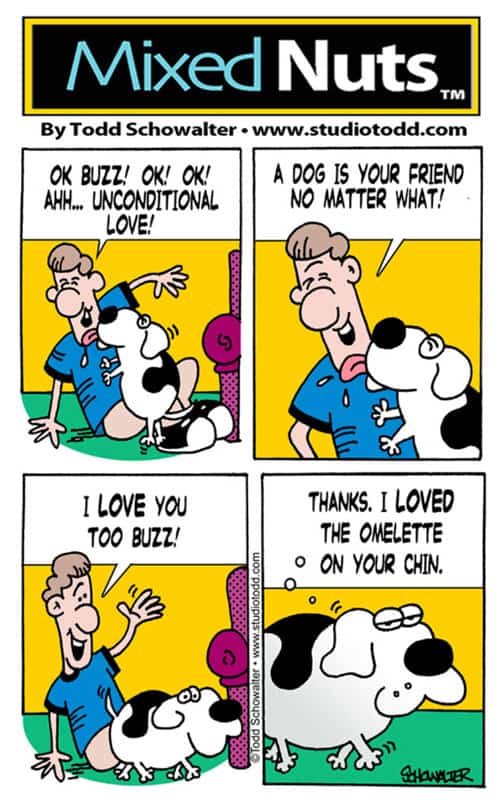 Todd: I’ll tell you the one that I’ve gotten the most mileage out of that was an accident. There are a lot of comics that I’ve really been excited about that I’ve done over the 30-year span actually longer than 30 years whether that I’ve liked for their editorial value or I’ve liked for their comic strip value or their humour.
Todd: I’ll tell you the one that I’ve gotten the most mileage out of that was an accident. There are a lot of comics that I’ve really been excited about that I’ve done over the 30-year span actually longer than 30 years whether that I’ve liked for their editorial value or I’ve liked for their comic strip value or their humour.
I had this one character that I did almost as a joke. Our house here in St. Louis is on a corner lot. Everybody walks their dogs, and typically the dogs would all poop in our yard. This turned out to be a big problem with a lot of people. I quickly I drew who is now Buzz the dog, he’s in a bunch of my work. I drew Buzz the dog, I put him on a sign and I put it out in the yard and the sign got stolen.
I thought okay, and so I put another one out, it got stolen. The other one got stolen. My neighbour asked me about it, “Can you draw me one?” I go, “I guess I could.” Hers got stolen. The funny thing is I thought, well, maybe there’s something here and just as a joke,
I had some signs manufactured and the signs went crazy. The poop free zone with Buzz the dog. The Buzz the dog character has now evolved into my logo, he’s got his own comic. He’s on t-shirts. He’s on all kinds of stuff. I wouldn’t say it was my best work but it was probably the strangest work with the most longevity to it. Having a dog poop in your yard turns into something I actually made some pretty good money.
We had these poop signs were in bases in Afghanistan. They were worldwide, and they’re still available somewhere. I’m thinking of bringing them back. It was crazy. Buzz the dog who’s still out there that is probably the character, again if he’s not my favourite, he was the most useful in many ways.
Rob: That’s really made me laugh. That’s great.
If you had a time machine and you could go back to the early days when you first started drawing cartoons, what advice would you give the young Todd?
Todd: Don’t colour inside the lines. There are too many rules. I had teachers as early as kindergarten, “Now you got to colour inside the lines.” I don’t want to colour inside the lines. “Well, you’re never going to get an A if you don’t colour inside the lines.”
It was always something like that. Don’t let any boundaries limit you. You may think that your style doesn’t fit or you think you know, I’ve got to copy of this person to be taken seriously. No. Typically, your style is already in you. You may have to perfect it. You may have to figure- polish it a little bit but everybody’s got their own personal style like anybody.
You’re making me say back in the day, I’m going way back in time are there certain cartoonists that I loved and I wanted to draw like them. That’s neat, but nobody wants a copy when there’s already the original and everybody inside has their own original ability and their own talent.
When I say don’t colour inside the lines, do your own work, regardless of how you feel about it. If you stick to it, you will develop over time, your own look, your own style, and that’s key, and then you’re the original.
Don’t try to copy too many people. You can take what’s good what some people do. People steal from people all the time to an extent, but make sure that you stay to your true roots and do your own style.
Rob: Jump back into the time machine and go forward this time. Go forward 10 years from now. What would you like to have achieved in the next 10 years when you look back?
Todd: What I’m doing right now is I’m putting together an animation studio. 10 years from now, I want to be producing a lot of content. Content is key right now.
With all the different streaming channels and your handheld devices and everything, there are new platforms that are coming out every day, unfortunately, content is in big demand right now. Actually, it’s not unfortunate. It’s fortunate for guys like me and guys in the profession.
What I would be doing 10 years from now is not just producing content for the sake of being content, but have a stylistic putting out content that is in a variety of different areas, whether it’s animation, print, books, which aren’t going away.
In 10 years from now, I’d like to have my animation studio really thriving with a brand that is recognizable to a lot more people than it is right now and bringing entertainment, great content to a lot of people.
Rob: Where can listeners see your work and contact you?
Where’s the best place for them to find you?
Todd: Just feel free anytime to visit me online. My site is studiotodd.com, www.studiotodd.com. You can visit me there, contact me there, telling me you hated me on this podcast there, whatever you want to do.
You can see my work, you can watch my demo reel. You can get back to me and I’ll get back to you as soon as possible as well. studiotodd.com. Not Toddstudio, Studiotodd. That’s the best bet.
Rob: I’ll make sure that all the links are in the show notes so that the listeners can find you easily.
Todd, thank you very much for an intriguing and very entertaining and enlightening podcast because I think you’ve got some really good things on the go.
You’re developing things for the cartoonists that I think will be amazing in the future. Thank you very much. It’s been an absolute pleasure talking to you.
Todd: It’s been a pleasure with me as well and I appreciate you having me on your podcast. Thank you, Rob.
